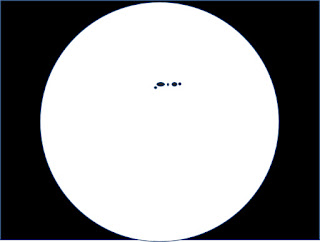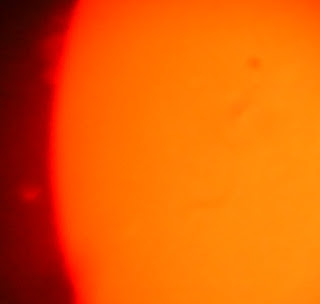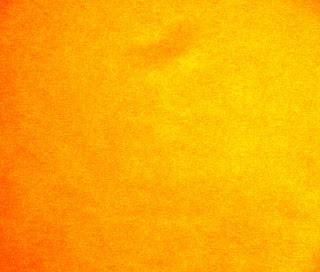June 30th 2115 GMT
Conditions were not great for the Venus/Jupiter conjunction. While they were behind a bank of cloud, I took 25 lunar images and ended up with this.
Despite trying several vantage points around the neighbourhood, I could not catch Venus and Jupiter through a telescope as I kept trying to dodge cloud. I finally caught it through cloud in the camera on its own.
June 30th 1000 GMT
Despite much better viewing conditions than the day before, a solar bin scan did not reveal any sunspots.
June 29th 2040 GMT
I did some shots of the Moon with my Nikon D3200 DSLR at 300mm and various settings. I stacked 6 images but was not too pleased with the results.
I did a separate set of shots with Venus and Jupiter. I processed the best one to get this.
June 29th 1250 GMT
With conditions somewhat hazy, I bin scanned the Sun rather than trying a photograph. New sunspot activity had rotated on.
June 28th 2100 GMT
I photographed the Moon and the close passage of Venus and Jupiter with the Nikon DSLR at 300mm.
June 28th 1800 GMT
I tried another solar white light shoot but there were no sunspots either.
June 27th 1000 GMT
I did a solar white light shoot but did not see any sunspots.
June 26th 2100 GMT
After a rainy day it cleared enough to show the Moon and Venus. I stacked 94 lunar frames taken with my Mak and Nikon D3200. I finished in GIMP.
Venus was somewhat more difficult, with some "ghost" images but I managed to catch the phase from a single frame.
June 25th 1020 GMT
It was back to moving cloud, so back to drawing. The sunspot group had rotated close to the edge.
June 24th 2045 GMT
I did a Moon shoot with the camera only at 300mm and got the focus right this time.
June 24th 0745 GMT
I did a solar hydrogen alpha shoot with my PST. The main area of interest was surrounding the sunspots.
June 24th 0715 GMT
I tried a prime focus shot of the Sun with my Maksutov and Nikon D3200 DSLR. I stacked 54 images in Microsoft ICE and finished in GIMP.
June 23rd 2045 GMT
I did a photo shoot of the Moon with my Maksutov and Nikon D3200 DSLR. I stacked 31 images.
June 23rd 0750 GMT
It was clear when I bin scanned the Sun on arrival at work. The sunspot group had changed again.
June 22nd 2040 GMT
I snapped the Moon in the dusk sky with the camera alone. The result was somewhat disappointing.
June 22nd 1140 GMT
Despite some moving cloud, conditions were far better than the day before. The rain had cleared to leave some very clear skies in between the clouds. The binocular view of the Sun was quite breathtaking and I felt a drawing did not do it justice. Still, I had a busy work day and did not have time to do a photo shoot.
June 22nd
Under heavy rain, I reprocessed a solar hydrogen alpha shot from November 13th 2011.
June 21st 1600 GMT
There was quite a lot of cloud around. I did a solar hydrogen alpha shoot and mots activity was around the sunspots.
June 21st 0915 GMT
Conditions were slightly better than the day before but far from ideal. The sunspot pattern had changed and rotated.
June 20th 0845 GMT
I bin scanned the Sun under poor conditions, with lots of moving cloud of all thicknesses but I managed to see the main sunspot group quite clearly. Apart from being quicker, the binocular scan has distinct advantages over photography under poor conditions.
June 19th 2100 GMT
I did a dusk shoot of the Moon, Venus and Jupiter with my Nikon D3200.
First up was the three together.
I tried some shots of the Moon on its own but it only showed the phase.
Venus and Jupiter together worked, though.
June 19th 0815 GMT
I did a hydrogen alpha shoot with 3 cameras. The conditions were clear and there was lots of activity around the sunspots. I could also see some small prominences.
June 19th 0650 GMT
I bin scanned the Sun in a clear sky and found that the large group had apparently split into at least 3 spots.
June 18th 2115 GMT
I went out with my Nikon D3200 DSLR and tried various settings to obtain widefield images of Venus with Jupiter. I chose and processed the best shot.
June 18th 0800 GMT
I bin scanned the Sun in a clear sky on arrival at work. New sunspot activity had emerged.
June 18th
June 17th
I reprocessed a solar hydrogen alpha photo from March 19th 2011.
June 16th 1055 GMT
While waiting for files to reload on my laptop, I checked the Sun. The active group was showing 4 sunspots under a clear sky.
June 15th 0845 GMT
It was still quite light but near Bedtime. I took some frames of Venus with ,my Mak and Konica Minolta DSLR and found the best results were ISO 800 and an exposure of 1/500 second.
The widefield shot was tough as the sky was still quite light. I used ISO800 and 1/4 second to get the best result.
June 15th 0705 GMT
Despite hazy conditions, I was able to view the sunspots. The old activity had rotated off and the new active region had changed shape.
June 14th 0800 GMT
The sky was unusually clear, considering the recent weather and some new sunspot activity had rotated on.
June 13th 1720 GMT
There was a small break in the cloud and I was able to see a sunspot close to rotating off.
June 12th
With heavy rain, I reprocessed a solar hydrogen alpha shot from June 26th 2011.
June 11th 0830 GMT
There was quite a lot of moving cloud but I could see a sunspot. It is likely that smaller ones could have been present but visible under better conditions or with larger instruments.
June 10th 1225 GMT
I bin scanned the Sun but saw just 2 sunspots, despite good conditions.
June 9th 0920 GMT
A second attempt at a solar bin scan found the sunspots.
June 9th
I found some images of Saturn using my Maksutov and DSLR, so stacked them. Although the image is too small, the rings are clearly visible.
June 9th 0755 GMT
I saw the last quarter moon above the trees. I could see some of the southern craters but could not pick out any individuals. Grimaldi was prominent.
I bin scanned the Sun but did not see any sunspots.
June 8th 0740 GMT
When I arrived at work, the Moon was in the west and a bit higher than the previous day. Grinmaldi was quite clear and there was a ray system below it.
A solar bin scan revealed that the sunspots had changed again.
June 7th 0750 GMT
The waning gibbous moon was low in the west, Grimaldi was prominent and I could just make out some of the southern craters, such as Clavius.
A bin scan of the Sun revealed that the sunspot pattern had changed, yet again.
June 6th 2225 GMT
There was still quite a lot of dusk around but I captured a pass of the International Space Station and Leo.
June 6th 1610 GMT
I went out with my PST and 2 compact digital cameras to cover full disc, wide field and close-ups. Despite the recent activity in "white light", the solar disc was somewhat bland.
June 6th 0955 GMT
I bin scanned the Sun and saw that there was some new activity.
June 6th 2310 GMT
There was still some cloud and twilight around but I took both DSLRs out on tripods. The Konica Minolta I set on 30 seconds exposure at ISO 800 and 18mm focal length. I snapped the Cygnus area, Cassiopeia and the Plough.
With the Nikon, I tried various exposures at 300mm and 100mm. I tried the Moon and Saturn but also lots of star fields around Cygnus, Lyra, Cassiopeia and Hercules.
First was Albireo.
First was Albireo.
Next was Cassiopeia.
I next captured part of Hercules.
and another part!
Finally, I took 14 lunar frames at 300mm and ended up with a passable result.
June 5th 2120 GMT
Dusk was somewhat cloudy but I finally managed to catch Venus and Jupiter in the same widefield camera view.
June 5th 0700 GMT
Conditions were somewhat hazy but, with bad weather forecast for later, I bin scanned the Sun. I was surprised to see the sunspots appeared clearer than the day before.
June 4th 2100 GMT
I went outside to look for Venus and Jupiter with the idea of catching them in a widefield photographic view. Unfortunately, that part of sky was cloudy and I could not see either planet. I saw an ISS pass, with its path not far from Arcturus and Vega.June 4th 0750 GMT
It was clear and sunny when I arrived at work and a solar bin scan revealed new sunspot activity.
June 3rd 0730 GMT
Despite moving cloud, I managed to find the sunspot that I missed the day before.
June 2nd
I reprocessed another solar hydrogen alpha shot from June 10th 2015 showing nice prominences.June 2nd 1230 GMT
I bin scanned the Sun. Although there was quite a bit of moving cloud, it was clear enough to have seen the sunspot, had it been as large and dark as two days before. However, I could not see it, suggesting that it had gone or faded below the visibility threshold.


















































































No comments:
Post a Comment